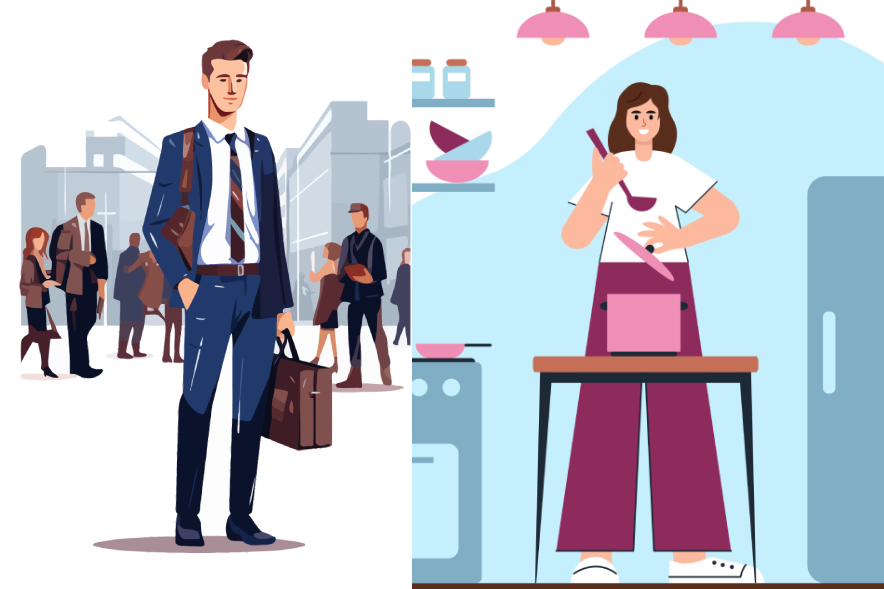Let's delve deeper into the evolution of gender roles, shedding light on how past expectations have transformed and what this means for us today. We'll expand on each traditional role, weaving in how society's view has shifted and how individuals navigate these changes.
1. The Male Breadwinner
Historically, men were seen as the financial anchors, often the sole earners in their families. This role was shaped by economic needs and cultural expectations. However, the modern landscape has changed drastically. With the rise of dual-income households, men are no longer the default providers, and the idea of financial responsibility is now shared. This shift allows men to explore roles beyond just breadwinners, embracing caregiving and other domestic responsibilities.
2. The Female Homemaker
In the past, women were primarily associated with domestic duties, managing the household and nurturing the family. This image, especially prevalent in mid-20th century America, has evolved as women increasingly participate in the workforce. Today, the concept of the female homemaker has expanded to include both genders sharing household responsibilities, reflecting a move towards more egalitarian domestic setups.
3. The Strong, Silent Man
The archetype of the stoic and emotionally reserved man has its roots in cultural narratives that value strength and self-sufficiency. This expectation for men to suppress emotions has gradually been challenged. Societal shifts now encourage men to express vulnerability and seek emotional support, leading to a healthier and more balanced understanding of masculinity.
4. The Nurturing Woman
Women have traditionally been pigeonholed as the primary caregivers, a role supported by societal norms and sometimes biological assumptions. However, the modern narrative recognizes nurturing as a human quality, not confined to one gender. Men are increasingly acknowledged for their nurturing capabilities, breaking down the gender divide in caregiving roles.
5. The Male Protector
This role, rooted in physical strength and bravery, casts men as the guardians of their families and communities. While the protector role still exists, its definition has broadened to include providing emotional and psychological safety, not just physical protection. It’s about creating a secure environment, irrespective of gender.
6. The Delicate Female
The perception of women as fragile and needing protection has seen a significant overhaul. Today, women are recognized for their resilience and strength. The changing attitude challenges the notion of delicacy, empowering women to take on varied roles in society, from leadership to physically demanding careers.
7. The Male Decision Maker
Men traditionally dominated leadership and decision-making roles. This landscape is shifting as women assert their presence in politics, business, and other areas requiring decision-making prowess. This change not only redefines gender roles but also promotes a more inclusive approach to leadership.
8. The Female Caretaker
The role of women as primary caretakers in families is expanding to recognize the shared responsibility of caregiving. Men are stepping into caretaker roles more visibly, with society increasingly valuing the importance of fatherhood, elder care, and emotional support as gender-neutral responsibilities.
9. The Adventurous Man
Historical narratives often glorify men as adventurers and pioneers. While this continues, there's a growing acknowledgment of women's adventurous spirits and achievements. This redefinition allows both men and women to pursue adventure and exploration, dismantling the old stereotype that bravery and adventure are solely masculine traits.
10. The Socialite Woman
Traditionally, women in high society were expected to be the primary nurturers of social connections. As networking becomes essential in professional and personal spheres, the role of the socialite has transformed. Both men and women now engage in building and maintaining social networks, reflecting a shift towards shared social responsibilities.
Reflecting on the Past, Present, and Future

The journey from traditional gender roles to the present shows significant progress in how we view and value the capabilities of individuals regardless of gender. These roles, deeply embedded in history, have evolved in response to economic changes, social movements, and a growing understanding of gender as a spectrum rather than a binary.
The conversation around gender roles is ongoing, reflecting a dynamic interplay between tradition and progress. As we continue to question and redefine these roles, we move closer to a society that appreciates diversity and embraces the potential of every individual, beyond gender constraints.
In sum, the narrative of gender roles is a story of transformation and growth. By examining our past, engaging with the present, and anticipating the future, we can better understand the complexities of gender dynamics and work towards a more inclusive world.
